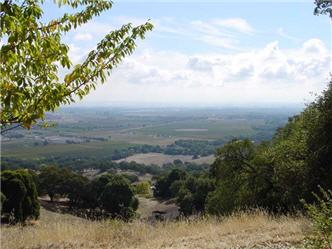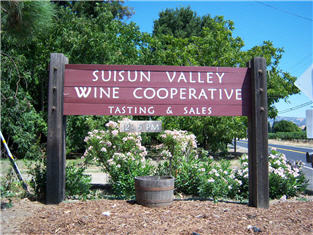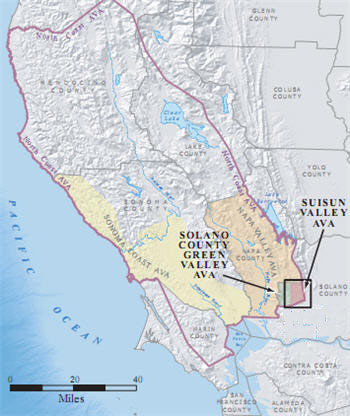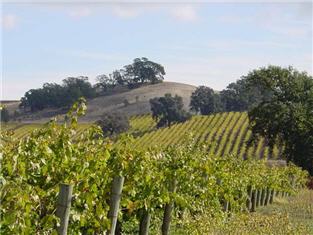

Although Suisun Valley is southeast of Napa, its climate can be cooler than one might expect.
Suisun Valley Transitions
from Bulk Grape Growing
to Premium Supplier
by
Jo Diaz
August 19, 2008
 uisun Valley, an appellation committed to growing ultra premium wine grapes, has a history that dates back to the 1800s. It has always been, and continues to be, a winegrape-grower driven appellation, versus a winery showcase destination. Today, the valley has approximately 2,000 planted acres, with additional scheduled replant activity slated for 2009. The Suisun Valley AVA was established in 1982.
uisun Valley, an appellation committed to growing ultra premium wine grapes, has a history that dates back to the 1800s. It has always been, and continues to be, a winegrape-grower driven appellation, versus a winery showcase destination. Today, the valley has approximately 2,000 planted acres, with additional scheduled replant activity slated for 2009. The Suisun Valley AVA was established in 1982.
Within Suisun Valley, there are only six operating wineries: Bask Cellars, Ledgewood Creek Winery, Sunset Cellars,

The Suisun Valley Wine Co-op tasting room showcases Suisun Valley brands such as Sunset Cellars, Bask Cellars, Blacksmith Cellars, King Andrews Vineyards, and Winterhawk Wines.
In order to expand their ability to become more of a wine destination, on June 11, 2007, Doug Sparks of Sunset Cellars opened the Suisun Valley Wine Cooperative. This tasting room location was formerly the West Wind Winery, which operated in Suisun Valley from 1988 to 1992. The tasting room showcases four more Suisun Valley brands, along with Sunset Cellars: Bask Cellars, Blacksmith Cellars, King Andrews Vineyards, and Winterhawk Wines.
The rest of the companies in Suisun Valley are operated by winegrape growers, catering to numerous, prestigious Napa and Sonoma wineries for inclusion in multiple product line programs. Interestingly, Suisun growers have also found East Coast wine buyers, as well as home winemakers, to whom they can successfully market their fruit.
The grape growers produce traditionally popular cultivars, as well as non-traditional spice rack varieties such as Syrah, Petite Sirah, Barbera, Gamay, Grenache, Mourvedre, Primitivo, Sangiovese, and Zinfandel.
For historical purposes, varietal grape growing for premium winemaking in Suisun Valley represents over a century of continuous viticulture. In the 1800s, vineyards were typified by classic head pruned vines in field-blend plantings. In the latter 1800s, Mangles Winery (long decommissioned and now gone) was just west of Suisun Valley Road near Cordelia. It represented one of the largest commercial wineries in the United States in its day, and produced wines from fruit grown in and around this location.
While phylloxera (and later Prohibition) did much to disrupt the local grape industry in the early 1900s, a strong rebound for grapes and wine commenced in the post WW II economic expansion. Wine industry cycles over the years have continued to increase viticultural acreage, change varietal plantings, and influence a continuous pursuit of quality gains.
Getting Their Act Together
More recently, the Suisun Valley Grape Growers Association (SVGGA) was created in 2003. The members have certainly seen their share of changes since their collective marketing association began. Suisun Valley winegrape growers’ fundamental challenge and impetus for forming as a grape growers’ association came with the sudden and major loss of key, corporate North Coast oral contracts for many of the farmers. In 2000-2001, just when a major corporation purchased Turner Road, the start of the oversupply period began. As is always the case in a time of oversupply, it caused large corporations to reconsider their grower relationships. In that process, those corporations severed most of their existing grower relationships with the Suisun grape growers.
came with the sudden and major loss of key, corporate North Coast oral contracts for many of the farmers. In 2000-2001, just when a major corporation purchased Turner Road, the start of the oversupply period began. As is always the case in a time of oversupply, it caused large corporations to reconsider their grower relationships. In that process, those corporations severed most of their existing grower relationships with the Suisun grape growers.
This proved to be devastating for the small companies. In order to begin a recovery for the AVA growers’ economy, they banded together. This collective-mind thought process allowed them to face the overriding fact that commodity based companies can easily become a downdraft to growers, when all conditions are perfectly in place. They consequently organized, strategized, and completely rethought the valley’s business model.
Knowing that the wine industry operates in cycles of oversupply then undersupply, the Suisun neighbors began to change grape growing practices. They instituted methods that would guarantee that the next cycle of undersupply would have their grapes ready for Prime Time.
According to SVGGA’s President Roger King, “We learned and developed a strategic plan that focused us away from any and all commodity-based production. This occurrence caused us to begin to specialize in ultra premium and luxury class supply for a new client base. Those clients would be searching for the best possible fruit available within the North Coast AVA, and our grapes would succeed because they’d also be priced very competitively.” Thus the Suisun Valley grape growers attacked and have now won recognition as a fundamental part of California’s North Coast.
The growers in Suisun Valley don’t see themselves as commodity growers in any sense of the word. Their vineyards are being planted with meticulous care, with the consideration of multiple and interlacing decisions for all their vineyard practices in order to achieve only the highest quality fruit. They also understand that in order to do things well, what they successfully achieved in the past on an intuitive level must now be validated by scientific studies regarding terroir definitions.
Weathering the Strum…and Drang
In April of 2006, growers arranged for the purchase of four new weather stations. In order to scientifically classify the microclimates within Suisun Valley, SVGGA collaborated with the Solano Irrigation District and the Suisun Valley Fund, and had four new stations installed so that they could collect weather data.With these stations added to two existing ones, the growers are now provided with a much more comprehensive collection of climatic statistics. These facts are

At the southeast corner of the North Coast AVA, Suisun Valley sports many vineyard views like this.
To help scientifically document their AVA, the organization has also enlisted terroir experts Terra Spase, Inc., of St. Helena, to undertake the scientific data analysis of the unique soils and climate of the Suisun Valley region.
By analyzing the existing data from the weather stations and leveraging these new










 READER FEEDBACK: To post your comments on this story,
READER FEEDBACK: To post your comments on this story,



